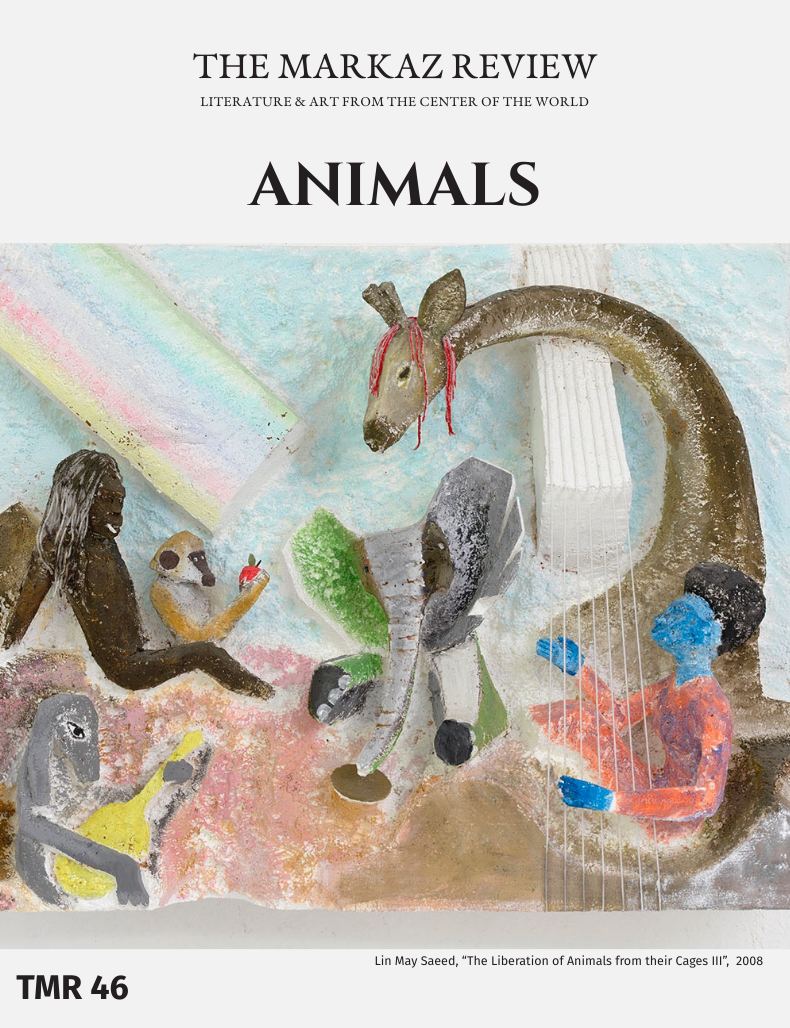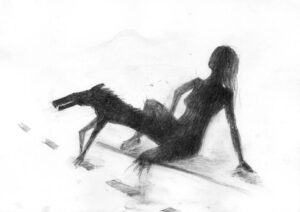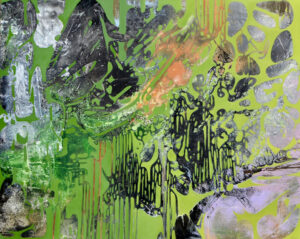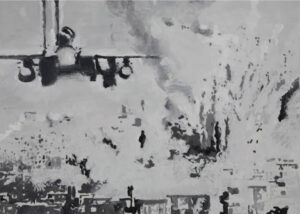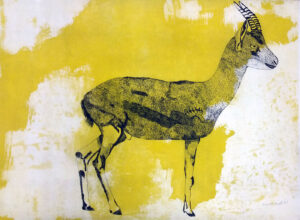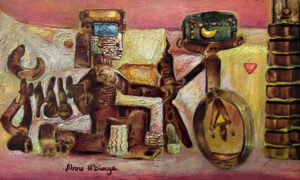In this Sufi tale, poet Shadab Zeest Hashmi explores the worlds inhabited by gazelles Sahel and Sahara, between the twenty-first century and eternity.
Early summer smelled like sweet milk, and up here on the lush slope, with a view of the city rising out of rock and shimmery water, two gazelles basked, chewing on acacia leaves. Far down below, a steel suspension bridge with tiny cars moving on it and tiny birds moving around it, stretched like the great wings of the mythic Simurgh bird itself— from end to end of the strait— connecting the busy earth with the busier heavens.
Drums were playing in the distance, children and fountains leaping, the sun warm and the breeze cool, everything edged with silver. Lying there amidst the wild grass and daisies, a deep sense of peace came over the gazelles. They felt as if they were crossing over the silver that rimmed the world, drifting gently to sleep. Sahel’s face rested on Sahara’s back, eyelids heavy with sleep. Sahara passed through an archway lined with books that had citrus-scented pages and spines made of carob pods. An ambulance squealed in the distance, a monarch hovered over Sahara’s nose, waking her from the dream she had just entered. She stirred and caught sight of a big bubble. “Look, a crystal grapefruit,” she said, squinting from the spell the dream had cast on her.
Sahel sat bolt upright. “More like a cantaloupe,” he said, eyes wide. “It’s a bubble they make out of soap-water.” Sahara, transfixed, replied in a whisper: “Something with eyes of its own, colors blinking within colors.” A rush of joy mixed with awe was coming over Sahara. She did not care about what the bubble was made of, only its glorious clarity, its strength, and delicacy that was awakening her from within. “It’s the dance of time. You can’t measure its glint. Or can you?” she continued, but he was gone.
Sahel sprang up and ran to see where the bubbles were coming from, who was blowing them. He ran and ran, across the hill, the park, the row of horse-drawn carts for tourists, careening past the thoroughfare, the high-ceilinged, red-bricked bazar, trams, a small mosque, its side-garden and fountains. He leapt over scooters and street vendors, dodged swinging pendant lamps, shocking people with his agility. Sahel sped through the avenues so fast, he was impossible to spot, until he took a leap over one of the self-driving cars newly arrived in the city and his hooves became stuck to the large spinning camera atop the car. The camera let out a siren and was jammed. The car, run by sensors beamed from satellites, stalled. Sahel, pulled every which way by beams, was catapulted so high and far, he shot through the Earth’s atmosphere, farther and giddier until the wet, green planet looked like balled up, damp newspaper.
Sahel had traveled as if sliding up a cat’s cradle of beams and now found himself by the mouth of a crater on a distant planet’s moon. The soil was the color of gravel but felt like warm jelly under his hooves. A pungent-sour smell made his stomach turn and he yearned for Sahara, for home and sweet acacia leaves.
Sahara, meanwhile, had had her gaze fixed on the bubble, eyes filled with tears, as it floated down, slow, elusive, but somehow with purpose. Wafts of cologne, sunscreen, and street-food filled the air, children chased each other without sandals, their parents holding cups of savory grapes and watermelons cut in cubes, which the children returned to with open mouths every now and then.
Sahara saw the bubble floating towards a chinar with sharp branches. A sparrowhawk flew past, a man tugged at his florescent kite, making it snarl at the bubble, a little boy took his hand out of his mouth and shrieked with joy, a girl ran backwards aiming to catch the bubble.
The colors swirled in the sun, so clear they looked newly invented. The bubble escaped branch and beak and syrupy little fingers, evil eyes, and frisky dogs. The spell over Sahara finally broke when the bubble was gone without warning. It vanished leaving no trace, not as much as a yelp from a child or the faintest gasp or murmur of disappointment from the crowd it had drawn, no languishing scent or spray of color. It was as if the crystalline wonder was of Sahara’s own conjuring, a figment.
The scene continued to be animated by other distractions: the antics of the ice-cream man in a red Fez, a lapdog’s shrill bark cutting through the live music, a waft bringing the aroma of roasted corn, then a chill in the wind that caused people to reach for pullovers and picnic blankets and scamper. Night was falling, the wind picked up even more and the hill became more and more deserted. Sahara’s heart sank. She was alone and stranded; she did not know how to get home without Sahel.
Sahara found the sweetness of the acacia vanish, the tickle of wild daisies underfoot was without joy, as was the velvety horizon warming up to stars. The world suddenly lost all vibrance; it was as if the sounds and sights around her were hitting and deflecting against each other in a kind of cold chaos. She missed Sahel sorely as she walked past the bazar, the tram station, until she stood before the life-size, rusty, mirrored window of a large warehouse. In it she saw the vast night and the city winking all manner of bright lights, rushing like a river, and a gazelle so small and still it looked as if it had been swallowed up by it all.
An owl’s hoot awoke Sahara from her reverie, and she followed the sound through the intermittent glow of traffic amidst the night shadows. Behind the warehouse was a cemetery. Turning the corner, she saw light from billboard screens flash on old trees and gravestones. Traffic noise was fading away, city lights dimming. In the hum of the nocturnal rustling and chirrups, Sahara heard the gentle rhythm of prayer, as she entered the cemetery. A young man was sitting beside a grave, reciting under his breath, brushing away twigs caught in webs from the carving on the gravestone that revealed a cypress within a cypress, a symbol for the deceased who passed away giving birth to a girl. He stood up, leaning against the trunk of the cypress that covered the grave, and began writing something in a notebook. His face was tear-stained. Who was he to the mother and child with the tree of life symbols on their grave? What part of the tree of life was his?
Sahara watched him, unobserved; his face seemed to multiply into a forest of pale faces whose radiance reminded her of the faceted beauty of the bubble. She raised her head to the cypress, and breathed in the peaceful scent, eyeing the moonlit graves. She sensed haloes of love that made the living and the dead equally present. It was a blossoming of the tree of life. She suddenly felt calm. Her fear and sadness left her.
She leapt up and felt the rush of cool air as she ran out of the cemetery, racing through the backstreets where people were gathering on palanquins, drinking tea, and smoking sheesha. Sahara gave many an errant Steppe eagle, wild dog, and poacher a good chase, running for miles, making her way home to Sahel.
Dawn was yet to break, and Sahara was yet to reach home. In the iridescence of a large bubble, a gazelle’s shape became visible in a clearing. It was Sahel, just returned home from a moon-crater where he had seen every law of physics warp, where neither his agility nor the sharpness of his antlers was of use against the lava-like creatures advancing, the sulfurous quicksand, and the freezing ground that numbed his hooves.
Sahel had returned but those few earth hours for Sahara had amounted to years for him in outer space. In all that time, he had discovered dimensions of intuition he had never paid attention to earlier. He had learnt that the bubble floating down, could also rise, and that, contrary to his certitude, it was not made of soap but light from a different sun. It had appeared out of nowhere to lead him back, and as soon as he arrived in his glade, the bubble burst into infinitesimal particles in dancing hues: zinc, tongue-pink, cobalt, aloe-green, lapis blue, persimmon, copper, and a rich, gold-specked black. Sahara missed the sight by minutes. She reached home breathless, elated, carrying the ripe scent of the tree of life.




